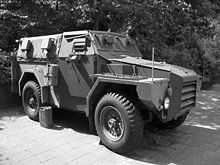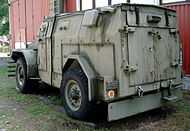Humber Pig
| Humber Pig | |
|---|---|
|
Mk 2 British Army Pig | |
| Type | Armoured personnel carrier |
| Place of origin |
|
| Production history | |
| Manufacturer |
Humber Rootes Group Limited Joseph Sankey & Sons Ltd. Royal Ordnance Factories. |
| Number built | ~1,700 |
| Variants | Mk 1, Mk 2 |
| Specifications | |
| Weight |
10,500 pounds (4.8 t) Mk 1 14,300 pounds (6.5 t) Mk 2 |
| Length | 4.93 metres (16 ft 2 in) |
| Width | 2.04 metres (6 ft 8 in) |
| Height | 2.12 metres (6 ft 11 in) |
| Crew | 2 + 6 (max. 8) |
|
| |
Main armament |
Limited fitting of
|
Secondary armament | none |
| Engine |
Rolls-Royce B60 6-cyl 4.2 litre petrol I-6 120 hp |
Operational range | 400 kilometres (250 mi) |
| Speed | 40 miles per hour (64 km/h) |
The Humber Pig is a lightly armoured truck used by the British Army from the 1950s until the early 1990s. The Pig saw service with the Royal Ulster Constabulary (RUC) from the late 1950s until 1970, when the trucks were transferred completely to the Army. The Pig became particularly well known from its presence on the streets of Northern Ireland during the worst of the Troubles.
History

The Humber Pig is based on the FV1600 series of four wheel drive 1-ton trucks manufactured for the British military by Rootes from 1952 to 1955.[1] The Pig is the armoured variant of FV1601 and FV1602. Originally designed as general-purpose military cargo trucks, body armour was fitted to fill the need for an armoured personnel carrier until the purpose-built Alvis Saracen could be delivered.[1][2] The armoured bodies were produced by GKN Sankey as well as the Royal Ordnance Factory and then sent to Rootes for final assembly.[3] Around 1700 Pigs were produced in total.[3]
The nickname "Pig" was first used informally, referring to the bonnet's resemblance a pig snout. Also, the Pig was fitted with a suspension not designed to support heavy armour and it had a tendency to sway greatly around corners — reinforcing the name "pig." This name found its way into semi-official parlance over time.[4]
After pre-production trials in Malaya and Cyprus were completed in 1956, plans were drawn up to convert existing FV1601-4 vehicles to a revised FV1609 design.[1] This variant featured a bolt-on armoured roof for the cargo compartment that could be removed for tropical environments. However, these plans were abandoned after twenty FV1609s were made, and the FV1601/FV1602 trucks were converted to FV1611/FV1612 spec instead—the first true Mk 1 Pigs.[1]
The series of mid-1950s IRA cross-border campaigns sparked the need for a greater military presence in Northern Ireland from the British Government. In 1956, the RUC requested a number of military vehicles to aid in patrolling the Irish border.
Deployment
Besides military use that began in 1957, Pigs saw first major action in Northern Ireland. The first ten FV1609 Pigs were delivered to the RUC in October 1958.[1] In 1960, several RUC Pigs were upgraded to the FV1611 specification with a integrated roof, after many faults were found with the vehicles during their two years of service.[1] These vehicles continued to serve until the late 1960s. In 1970, all Pigs were withdrawn from police service; however, the security situation in Northern Ireland worsened shortly after their withdrawal and the Pigs were soon brought back into use by the British Army.[2] The nimble truck chassis proved ideal for urban internal security duties, and ended up serving longer than the larger, heavier Saracens that were intended to replace them.
As the Troubles in Northern Ireland escalated during the 1970s, the Army Pigs were further modified with additional internal armour. These were referred to as Mark II vehicles. Further external modifications made the Pig perhaps one of the most aggressive looking military vehicles ever manufactured. The last of the Mark II Pigs were removed from service in the early 1990s.
Variants
Official Designations
- FV1601, FV1602 — Cargo and FFW (fitted for wireless) Humber GS trucks with added armour plating
- FV1609 — FV1601/02 vehicle with removable rear roof, canvas roof, and removable windscreens
- Mk 1 FV1611 and FV1612 - FV1601/02 vehicles converted to Mk 1 Pig spec with fully integrated rear roof and additional armour
- FV1620 — Humber Hornet, a FV1611 dedicated Malkara missile-launching platform
- Mk 2 FV1611 and FV1612 —Additional armour for protection against small-arms fire and rocket propelled grenades, "barricade removers" (heavy-duty bull bars) which enabled them to force their way through barricades erected in the streets.
Unofficial Designations
Some vehicles were equipped with the machine gun turret from the Shorland ISPV. All below were developed for use in Northern Ireland:
- Flying Pig — FV1611 with extending riot screens either side and roof
- Holy Pig — fitted with rooftop hatch surrounded by perspex screen (reference to the Popemobile)
- Kremlin Pig — fitted with wire screening for protection against rocket propelled grenades (RPG-7)
- Squirt Pig — fitted with a water cannon beside driver for riot control
- Foaming Pig — fitted with a foam generator to diffuse bomb blasts
- Felix Pig — modified for bomb disposal duties
Gallery
-
Mk 2 Pig in Tri-Colour Desert Camouflage
-

Pig rear view
-

The interior of a Humber Pig seen from the rear
-
Humber Hornet
See also
- Land Rover Tangi
- List of armoured fighting vehicles
References
- ↑ 1.0 1.1 1.2 1.3 1.4 1.5 Elliot, Clive. "Humber Pig: That's Not Right" (PDF). War Wheels. Retrieved 31 December 2014.
- ↑ 2.0 2.1 "Humber Pig, The Collections". Aldershot Military Museum. Hampshire County Council. Retrieved 30 December 2014.
- ↑ 3.0 3.1 "British Humber "Pig" Armoured Personnel Carrier". Khaki Korps Imports. Retrieved 31 December 2014.
- ↑ Elliot, Clive. "Military Vehicles". Park Royal Vehicles. Retrieved 30 December 2014.
External links
| Wikimedia Commons has media related to Humber Pig. |
| ||||||||||||||||||||||||||


